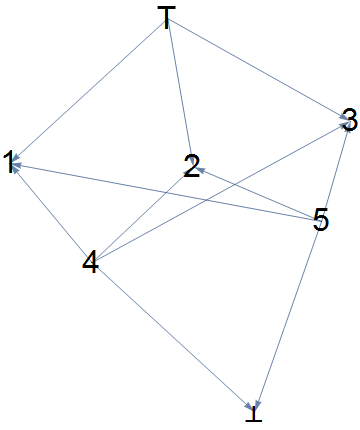In my thesis, I need to find all Up-sets of the set in the picture below using the order provided in the picture. I tried to code this problem with Mathematica but I can't find a nice and optimal algorithm. A definition of Up-set is given in this link:https://en.wikipedia.org/wiki/Upper_set. For instance in the first picture, green set is an up-set. because "for any element in this set such as x, all element that such as y, such that x<= y are is this set". I need to coding this definition to find all up-set for an arbitrary set with an arbitrary order.
$\begingroup$
$\endgroup$
2
-
$\begingroup$ You need to provide the ordering, so you'd need a directed graph. What are the T and inverted T supposed to denote? $\endgroup$– Sjoerd C. de VriesCommented Dec 13, 2016 at 20:01
-
$\begingroup$ They are biggest and smallest element on order relation and we can replace a,b,c,d,e with 1,2,3,4,5. Actually thy are not comparable necessary. $\endgroup$– Jamal FarokhiCommented Dec 13, 2016 at 20:12
Add a comment
|
2 Answers
$\begingroup$
$\endgroup$
I'm not sure whether I fully interpreted your initial drawing and description correctly, but would the following work for you?
Your set as a Graph:
g = Graph[{"T", 1, 2, 3, 4, 5, "⊥"},
{"T" -> 1, "T" -> 2, "T" -> 3, 4 -> 1, 4 -> 2, 5 -> 2, 4 -> 3,
5 -> 3, 5 -> 1, 4 -> "⊥", 5 -> "⊥"},
VertexLabels -> Placed["Name", Center],
VertexLabelStyle -> Directive[FontSize -> 32],
VertexCoordinates -> {{245, 446}, {103, 316}, {268, 313}, {409, 354},
{177, 227}, {383, 264}, {323, 93}}
]

With this representation VertexComponent[g, #] & gives you the UpSet of the vertex you apply it on. So the lists of all UpSets is given by:
VertexComponent[g, #] & /@ VertexList[g]
(* {{"T"}, {1, "T", 4, 5}, {2, "T", 4, 5}, {3, "T", 4, 5}, {4}, {5}, {"⊥", 4, 5}} *)
$\begingroup$
$\endgroup$
set = Range[4]
subsets = Subsets[set];
rg = RelationGraph[SubsetQ[#1, #2] && Length[#1] == Length[#2] + 1 &,
subsets, VertexSize -> 0.7, VertexLabels -> Placed["Name", Center],
VertexLabelStyle -> Directive[Red, Bold], VertexStyle -> White]
upset[n_] :=
Module[{sel = Select[VertexList[rg], MemberQ[#, n] &],
v = VertexList[rg], e = EdgeList[rg], com, h},
com = Complement[v, sel];
h = Thread[sel -> Green]~Join~Thread[com -> White];
Graph[v, e, VertexCoordinates -> GraphEmbedding[rg],
VertexStyle -> h, VertexSize -> 0.7,
VertexLabels -> Placed["Name", Center],
VertexLabelStyle -> Directive[Red, Bold], ImageSize -> 600]
]
So finding upsets 1,2,3,4:



